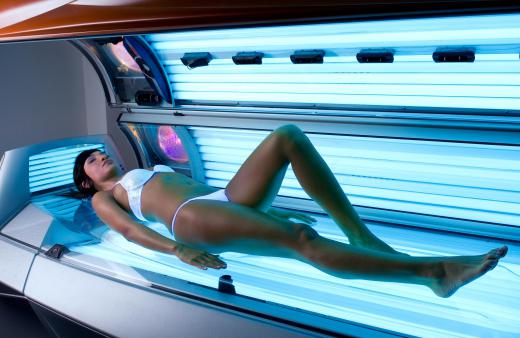Ultraviolet light bulbs are bulbs similar to other incandescent light bulbs that produce higher amounts of ultraviolet (UV) light than other bulbs. These light bulbs can be used in a number of different industries and fields, from plastics and paper that are cured using UV light to tanning beds, bug zappers, and even microbial sterilization. Less effective versions of UV bulbs can also be made by using standard incandescent light bulbs and altering the glass of the bulb in order to filter out more non-UV light. Ultraviolet light bulbs are typically specialized bulbs, however, that often have glass that is treated to further increase the UV output of the bulb.
Sometimes also called black lights or “blacklight” blue bulbs, ultraviolet light bulbs can be used for a number of different industrial, commercial, and residential purposes. High-quality ultraviolet light bulbs are typically made using mercury vapor lamps or specially designed light-emitting diodes. These bulbs emit light like other incandescent bulbs but tend to emit more light in the ultraviolet range, which has a short wavelength that cannot be perceived by the human eye. UV bulbs are then typically produced using glass called Wood’s Glass developed by Robert Wood, an American inventor who worked in the early 20th Century.

This glass allows UV light to escape the bulb but does not tend to emit much other visible light, producing a bulb and light that appears violet or purple, often referred to as a “black light.” Ultraviolet light bulbs used in commercial and industrial applications often utilize this type of glass, though it is fairly expensive so many UV bulbs use specially made incandescent filaments to save on costs. These bulbs do not produce as much UV light, however, so they typically run much hotter than higher quality ultraviolet light bulbs and have a shorter lifespan.

Industrial applications for ultraviolet light bulbs typically include the use of UV light to cure UV coatings on paper, glass, plastic, and other materials. These coatings are applied to the material, and the UV light is used to cure the coating into a stable, solid state. This can be done for a number of reasons, including coating paper to fluoresce in UV light, increasing UV protection in sunglasses, and applying marks to materials, such as money or credit cards, that can only be seen under UV light.
Ultraviolet light bulbs are also often used in other commercial applications, such as for tanning beds and sterilization. Medical or biological research facilities often use intense UV light to ensure microbes and bacteria are rendered harmless on equipment; many food processors and restaurants also use UV light to increase food safety. Forensic investigators often use UV lights to search a crime scene for blood or other bodily fluids that may have been cleaned away but still remain in ways not readily visible to human eyes. Lamps that attract and kill insects, often called bug zappers, typically use UV light bulbs as well, since insects are attracted to UV light.
